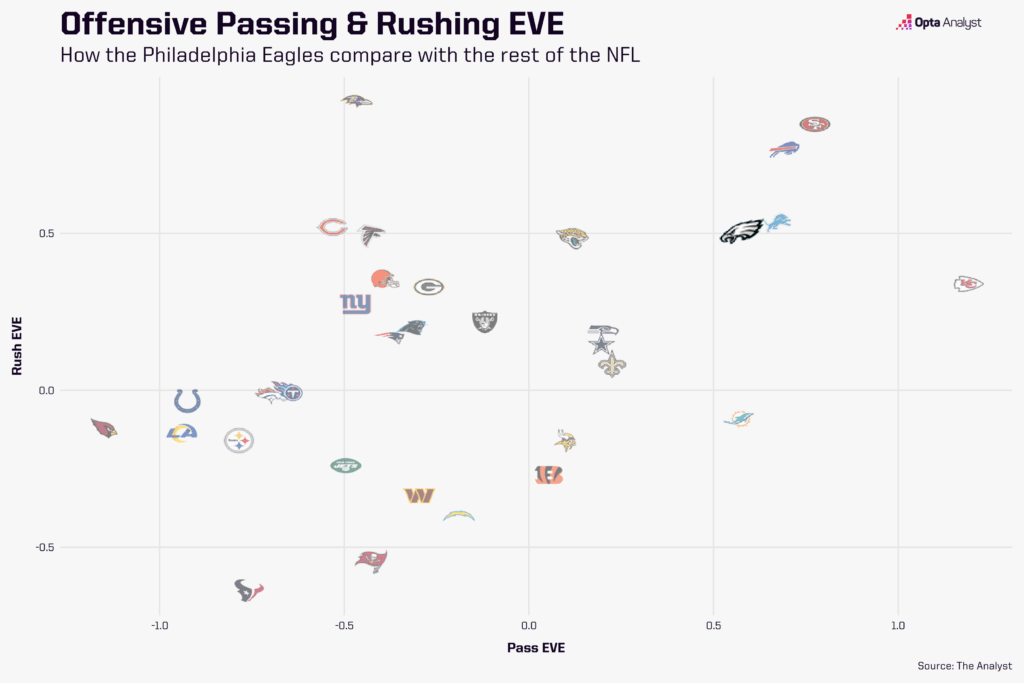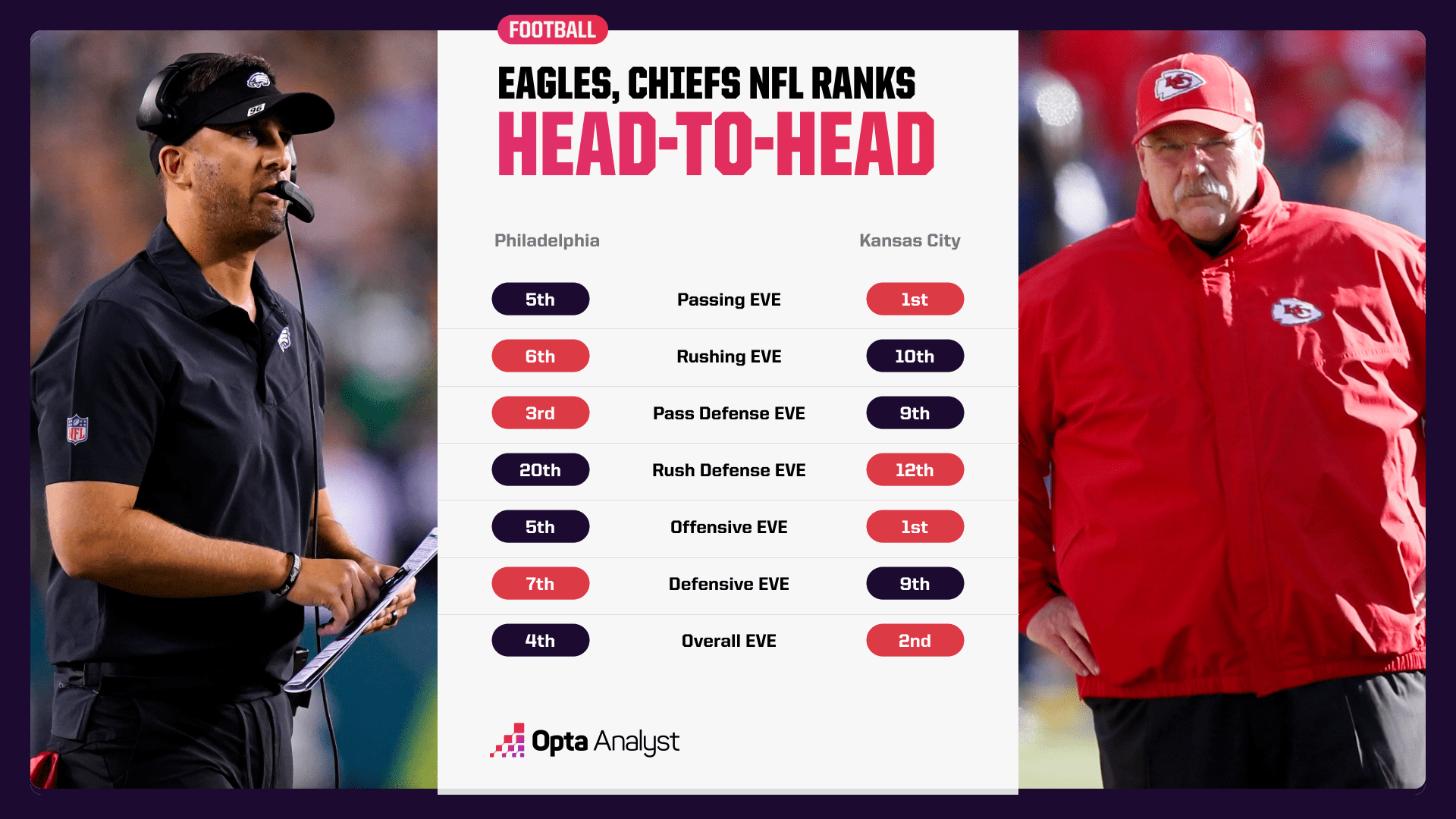The Philadelphia Eagles would make recent history with a Super Bowl LVII win over the Kansas City Chiefs and prove that a heavy rushing attack can be as effective as an elite passing game.
The Eagles were the rare team to run the ball more often than they passed this season. And those teams typically don’t make it this far in the postseason.
The Eagles ranked 23rd this season in drop-back rate, calling a passing play 56.7% of the time. Including scrambles, however, they ranked fourth with a 50.0% rushing play percentage. They would become the first team to win a Super Bowl with more rushing attempts than passing attempts plus sacks on the season since the 2013 Seattle Seahawks if they beat the Chiefs next Sunday.
This postseason, Philadelphia has attempted just 49 passes to 88 carries while cruising to victories over an outmatched New York Giants team and a San Francisco 49ers squad unable to throw the ball while Brock Purdy nursed an elbow injury. Passing the ball is intrinsically more valuable in football, but the Eagles have proven success can still come with a strong rushing attack and that teams can still make the Super Bowl with significantly different offenses.
A mobile quarterback and a strong offensive line are requirements, however, and how the Eagles have made it work this season.
Based on offensive EVE, the Eagles owned the fifth-most efficient offense over expectation this season. The unit ranked fifth in passing EVE and sixth in rushing EVE. They were first in rushing success rate.

It helps, of course, that Jalen Hurts, A.J. Brown, Devonta Smith and Dallas Goedert also accounted for a high-powered passing attack, so they only faced a heavy box 45.5% of the time – 16th in the NFL and below the league average. But it’s still notable that the Eagles could make a Super Bowl with the amount of running they did this year. And teams that rush for more yards than their opponent in the Super Bowl have gone a combined 41-14.
Of the top eight offenses in rushing EVE, only the San Francisco 49ers and Detroit Lions didn’t have significant rushing threats at quarterback. The Baltimore Ravens, Buffalo Bills, Chicago Bears, Eagles, Atlanta Falcons and Jacksonville Jaguars all had QBs with over 60 rushing attempts this season. Among quarterbacks on those teams, only Bills QB Josh Allen finished this season with a higher passing EVE than Hurts.
It represents an interesting dichotomy that the Chiefs were third in the NFL in drop-back rate this season. And why wouldn’t they with Patrick Mahomes under center throwing to Travis Kelce and his expansive list of wide receivers? It might come as a slight surprise that the Chiefs ranked first in passing EVE this season despite trading away wide receiver Tyreek Hill to the Miami Dolphins last offseason. The passing attack previously ran through Hill and Kelce perhaps to a detriment at times. Kansas City has added wide receivers JuJu Smith-Schuster, Marquez Valdes-Scantling, Justin Watson, rookie Skyy Moore and Kadarius Toney.
It was debated before the season whether the sum of those parts would equal Hill, and well, it did. Kelce took on more targets, but the focus was adjusted away from two targets and onto an entire offense, allowing Mahomes to spread the ball around. Kansas City’s receivers led the NFL with a 68.5% burn rate, while the Eagles were sixth at 60.8%. The Chiefs also led the league with an 81.8% open rate.
Philadelphia was 17th with a 77.1% open rate. Brown and Smith are differently shaped wide receivers. Brown is a tank at 6-foot-1, 226 pounds, while Smith is a relative twig at 6 feet, 170 pounds. But both receivers have the skill set to win contested catches against opposing defensive backs, which doesn’t require them to get as open.
Philadelphia’s passing attack was also less spread out. Brown, Smith and Goedert accounted for 78.1% of the team’s receiving yardage this season. Running backs Kenneth Gainwell, Miles Sanders and Boston Scott barely contributed in the passing game, and No. 3 wideout Quez Watkins only gained 354 receiving yards. Goedert missed five games, but Philadelphia was fortunate that Brown and Smith were able to stay on the field.
The Chiefs were not as good at running the football as Philly and also didn’t need to pound the rock to win. Kansas City was first overall in offensive EVE during the regular season, ranking first in passing EVE but just 10th in rushing EVE.

Hurts accounted for most of the difference in the rushing disparity between these two conference champions. He has 185 rushing attempts for 833 yards with 15 touchdowns on the season, including the playoffs. And only 55 of those rushing attempts were scrambles. Mahomes, on the other hand, carried the ball 67 times for 374 yards with four touchdowns, and 53 of those attempts were scrambles.
So Hurts had 130 designed runs to Mahomes’ 14. And just 29.7% of Hurts’ rushing attempts were scrambles, while 79.1% of Mahomes’ rushing attempts were not designed runs. The Chiefs got more creative with non-QB and running back rushing attempts with 23 total. Eagles wide receivers ran the ball just four times all season.
And Philly had considerably more rushing attempts by running backs as well. Sanders, Gainwell, Scott and Trey Sermon combined for 434 rushing attempts, and the Eagles had a clear bellcow in Sanders, who accounted for 1,403 rushing yards and 13 touchdowns on 287 attempts. Chiefs running backs Isiah Pacheco, Jerick McKinnon, Clyde Edwards-Helaire and Ronald Jones combined for 370 carries. Pacheco, a standout rookie, led the way with 192 rushing attempts for 951 yards with five touchdowns even though the Chiefs didn’t start heavily leaning on him until midseason.
We can also look at our concept data to further break down the differences, or lack thereof, in the rushing attacks and passing games.
The Eagles used inside zone on 29.3% of their rushing attempts, which was the 11th-highest rate in the NFL. They used zone read on 16.4% of running plays – the second-highest rate in the league – outsize zone on 15.8% of running plays (18th), counter 14.7% of the time (seventh) and draw 5.8% of the time (fourth).
The Chiefs used inside zone 33.1% of the time (sixth), outside zone 21.9% (sixth), counter 13.7% (eighth), power 8.2% (ninth) and zone read just 4.9% (18th). They used quick game as their primary passing concept, ranking 15th with a 36.0% rate. They were 17th in drop-back rate (32.6%), 14th in screen rate (10.0%), 28th in play action (9.6%) and fifth in RPO rate (fifth).
The Eagles, on the other hand, ranked fifth in drop-back rate (36.6%), 29th in quick game (27.7%), 10th in screen rate (11.7%), 26th in play action rate (10.5%) and first in RPO rate (10.0%).
Based purely on concepts, the offenses are pretty similar with west coast roots. Sirianni’s first offensive coordinator job in the NFL came in 2018 under then-Indianapolis Colts head coach Frank Reich – a Reid disciple. The Eagles just run the ball a lot more than Kansas City, and we’ll find out next Sunday if that approach can lead them to the title.
The Chiefs understandably like to pass in every situation. They led the NFL passing rate in both expected rushing and passing situations. They were second in passing rate with a neutral expectation. The Eagles were less predictable on offense this season. They liked to run the ball with an expected running play and expected passing play, and they liked to pass with a neutral expectation. They ran less with a neutral expectation and didn’t typically pass in anticipated rushing or passing situations.
Neither team actually matches up great with its opposing defense. Kansas City’s defense only really struggles to defend passing plays in expected rushing situations and rushing plays in neutral situations. Philadelphia’s defense thrives against the pass and only struggles against the run in expected passing and rushing situations.
So both teams might need to break from their comfort zone to exploit mismatches in the Super Bowl.
Both the Chiefs and Eagles have offensive lines that rank among the best in the NFL, though Philadelphia’s is considerably better with Jordan Mailata at left tackle, Pro Bowl left guard Landon Dickerson, All-Pro center Jason Kelce, right guard Isaac Seumalo and All-Pro right tackle Lane Johnson. The Eagles were the only team with a run disruption rate under 50.0% this season (44.7). The Eagles averaged 3.33 yards before contact per attempt, ranking third in the NFL.
The Chiefs ranked third with a 56.3 run disruption rate and were seventh with 3.13 yards before contact per attempt. Philadelphia’s offensive line ranked seventh with a 33.9 pressure-allowed rate, while the Chiefs were 11th with a 37.0 pressure-allowed rate.
It’s a fascinating Super Bowl matchup between the Eagles and Chiefs, and beyond their offensive approach, the teams are more similar than they are different. Both have mobile quarterbacks, strong offensive lines, top-tier pass catchers and defenses that rank in the top 10 in overall EVE.
The Chiefs have a clear advantage at quarterback in Mahomes, and they also might be better prepared for the Super Bowl after facing tougher competition in the postseason. But if the Eagles can get out to an early lead against Kansas City, they have a rushing attack and offensive line that can put away the game. And Hurts is a rising star in the league who has gotten better every college and pro season he’s played.
